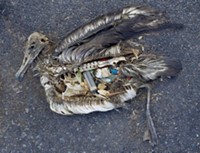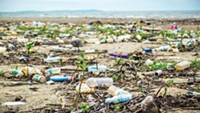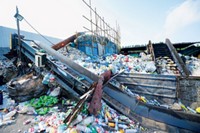Advertisement
Grab your lab coat. Let's get started
Welcome!
Welcome!
Create an account below to get 6 C&EN articles per month, receive newsletters and more - all free.
It seems this is your first time logging in online. Please enter the following information to continue.
As an ACS member you automatically get access to this site. All we need is few more details to create your reading experience.
Not you? Sign in with a different account.
Not you? Sign in with a different account.
ERROR 1
ERROR 1
ERROR 2
ERROR 2
ERROR 2
ERROR 2
ERROR 2
Password and Confirm password must match.
If you have an ACS member number, please enter it here so we can link this account to your membership. (optional)
ERROR 2
ACS values your privacy. By submitting your information, you are gaining access to C&EN and subscribing to our weekly newsletter. We use the information you provide to make your reading experience better, and we will never sell your data to third party members.
Pollution
Covid-19
Single-use plastics have boomed during COVID-19. Joana Correia Prata wants to reverse the trend
University of Aveiro microplastics researcher and veterinarian recommends policy priorities for dealing with plastic waste
by Carmen Drahl, special to C&EN
July 26, 2021
| A version of this story appeared in
Volume 99, Issue 27

In the past 2 decades, countries, municipalities, and manufacturers alike had pledged to reduce their plastic waste and recycle more plastic. Then COVID-19 happened. Governments rolled back regulations and people increased their consumption of plastic masks, gloves, takeout packaging, and more. Recycling centers temporarily closed just as stay-at-home orders triggered falling oil prices that made manufacturing more virgin plastic a bargain. Researchers are already noticing an impact on the world’s oceans.
Vitals
▸ Hometown: Porto, Portugal
▸ Education: BS-MS, veterinary medicine, University of Porto, 2016; PhD, biology and ecology of global change, University of Aveiro, expected 2022
▸ Favorite book:The Island of Doctor Moreau. It’s about how things can go wrong if you do not do good science.
▸ Favorite element: Silver, because it’s my family name (Prata) in Portuguese.
▸ Personal habits for reducing plastic waste: I always carry a cotton bag in my pocket. I wear reusable masks unless I’m obligated to use disposable ones. And I recycle everything. I would like to do more, but it’s difficult if not impossible to have a busy life and avoid all plastic.
▸ Hobbies: I have a website, O Meu Animal. As a veterinarian, I wanted to provide science-based information in Portuguese about how to care for animals.
Joana Correia Prata was alarmed. Since March 2020, the veterinarian and microplastics researcher at Portugal’s University of Aveiro has coauthored multiple publications recommending policy priorities for managing the boom in plastic waste. Carmen Drahl spoke with her about the scope of the problem and her hopes for the future. This interview was edited for length and clarity.
Support nonprofit science journalism
C&EN has made this story and all of its coverage of the coronavirus epidemic freely available during the outbreak to keep the public informed. To support us:
Donate Join Subscribe
Why did you switch careers from veterinary medicine to microplastics and plastic waste?
It is actually not a switch. Veterinary medicine covers a wide range of subjects, including environmental health. Right now, I’m working mostly on environmental health related to microplastics. My colleagues and I apply the One Health approach, a worldwide public health strategy that recognizes the interdependence of humans, animals, and the environment. They are all connected, so if we disturb one of them, we disturb the others. We can see this in the likely cause of the COVID-19 pandemic because disruptions to animals’ environments and close contact between animals and people facilitate the spread of new diseases.
What triggered you to look at plastic waste policies during the pandemic?
My colleagues and I want our science to influence society, so we were always interested in policy. When the pandemic began, we were seeing litter—masks and gloves. This was not only happening in Portugal. Our collaborators in Canada, China, and Spain saw the same trend. We knew that there was a problem and that people were not aware of it. Maybe they were not associating disposable masks with the problem of plastic waste. We felt the need to warn them.

How much additional plastic trash has the pandemic generated?
For now, we do not have accurate statistics. Official data from environmental agencies take 1–3 years to come out. We have some estimates. For instance, our research group has estimated that in 1 year, the use of disposable masks by the public, excluding health-care settings, generates 3.5 million metric tons of additional plastic waste (Chem. Eng. J. 2021, DOI: 10.1016/j.cej.2021.131201). That’s just for masks, which seem so light and so small in comparison to other things.
Why do you think governments decided to relax restrictions on single-use plastics like grocery bags during the pandemic?
I think a big part of it was fear that reusable products could carry the virus and increase transmission. At the beginning of the pandemic, nobody knew how transmission worked. Governments were put in a difficult place. They needed to manage plastic waste, but they also needed to manage public health and keep the economy moving, which facilitated the use of disposable products. It was not an easy decision. Nothing in this pandemic has been.
The US Centers for Disease Control and Prevention now says that contaminated surfaces are no longer thought to be a common way that COVID-19 spreads. Which kinds of single-use plastic are still important for us to keep using while the COVID-19 pandemic continues?
The most important single-use plastics are personal protective equipment for health care. Disposable medical supplies are a must. They usually are well managed from a waste standpoint. They go in a different waste stream from the waste produced in our homes. Anything potentially infectious goes to incineration.
The general public is not in such a demanding environment, so we can try to find alternatives to single-use plastic bags and disposable masks, for example. Reusable shopping bags can be washed. There are alternative packaging solutions based on paper. Some reusable masks on the market have undergone testing and offer filtration capacities similar to surgical masks.
The pandemic did some damage to the momentum society had to restrict single-use plastic. How hard is it going to be to pick up where we left off?
We’ve seen that some states and cities that postponed or reversed restrictions on single-use plastics at the beginning of the pandemic have reinstated their policies. However, I think the problem may be with mindset. Disposable products may have become more acceptable to consumers due to concerns with surface contamination. We will need to understand that single-use plastics, the ones we use just for a few moments and throw away, are not sustainable. If we create uncontrolled environmental problems from unsustainable use of materials, that can lead to public health threats in the future.
What should governments do so that more sustainable practices will be in place in time for the next pandemic?
Waste management systems were not prepared for COVID. At the beginning of the pandemic, Wuhan couldn’t handle the high amounts of medical waste. We need to create more resilient waste management systems because something like an outbreak, a hurricane, or a flood will always be happening somewhere in the world.
Relying on disposable products, especially disposable personal protective equipment, easily creates shortages because it takes time for production to adjust. Having reusable options can contribute to public health. Requiring minimum percentages of recycled material creates a market for recycled plastic since it is hard to compete on price, consistency, and availability with virgin plastics produced directly from oil. Governments should regulate the whole life cycle of plastics, from design and production to use and disposal.
How hopeful are you that society can solve the plastic waste problem?
I’m not very hopeful on environmental issues because there are so many, from climate change to plastics to chemical contaminants in water. There is so much pressure on the environment, but I think if we really want to do something, we can do it. We banned chlorofluorocarbons to protect the ozone layer, although plastics are more difficult to ban than CFCs because they have more applications. Think about COVID-19 vaccines: the development was so fast. If we really want to tackle a problem, we can do it. We just need to focus on it.

Carmen Drahl is a freelance writer based in Washington, DC, who covers the chemistry-biology interface. An earlier version of this story appeared in ACS Central Science: cenm.ag/prata.





Join the conversation
Contact the reporter
Submit a Letter to the Editor for publication
Engage with us on Twitter